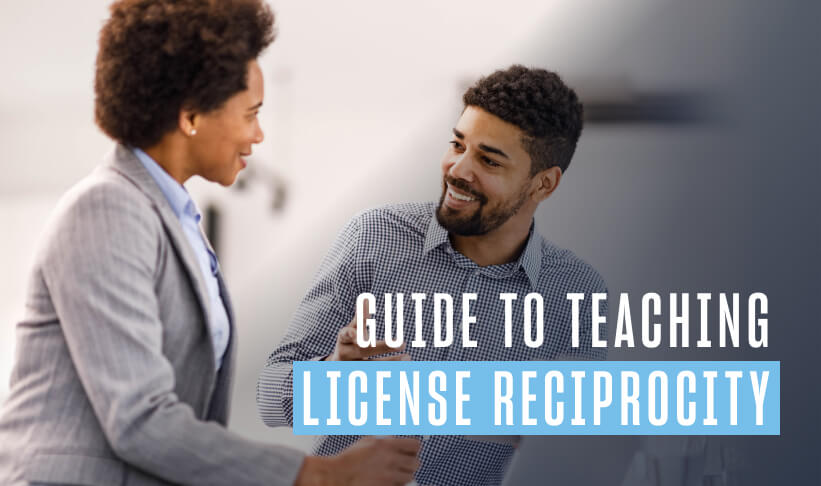Moving to another state and need to transfer your teaching license? Navigating the teaching license transfer process can be complex, which is why it’s important to research the steps before you start.
The teaching license reciprocity system allows teachers to transfer their credentials across state lines without needing to start from scratch. By understanding the benefits, requirements and limitations of teaching license reciprocity, educators can streamline their relocation and continue their careers with minimal disruption.
What Is a Teaching License?
A teaching license is an official credential granted by state education departments that authorizes individuals to teach in public schools, from pre-kindergarten through twelfth grade. This license is a mandatory requirement for anyone who works as a teacher in a public school, as it ensures that they meet their state’s standards for professional competency and ethical conduct. The process of obtaining a teaching license typically involves fulfilling specific educational and student teaching requirements, passing certification exams and undergoing a background check.
In addition to initial qualifications, maintaining a teaching license requires ongoing professional development and periodic renewal, generally every five years. Teachers must engage in continuing education to stay current with educational practices and standards. Certain specializations, such as teaching specific grade levels, subject areas or special education, may require additional licenses. These requirements ensure that teachers are perpetually well-prepared to provide high-quality education to their students.
Want the Brochure for USD’s Online Master of Education Degree?
Earn your M.Ed. in just 20 months with a program designed for working professionals.
What Is Teaching License Reciprocity?
Teaching license reciprocity enables educators who hold a valid teaching license in one state to apply for and receive a license in another state without needing to complete the initial licensing requirements all over again. Managed by the National Association of State Directors of Teacher Education and Certification (NASDTEC), this system is designed to facilitate the mobility of teachers across state lines and mitigate the nationwide teacher shortage that has existed since before the COVID-19 pandemic.
The reciprocity system operates through a collection of over 50 individual agreements, covering U.S. states and some Canadian provinces, that outline which credentials each state will accept. However, these individual agreements are not necessarily reciprocal; for example, Georgia may accept teaching licenses from Connecticut, but Connecticut might not accept licenses from Georgia.
While teaching license reciprocity streamlines the application process and helps both employers and teachers navigate specific state guidelines, it is important to note that there is still a significant amount of paperwork involved in transferring a teaching license. Despite the administrative burden, reciprocity usually prevents teachers from having to earn an entirely new credential, saving time in the long run.
Benefits of Teaching License Reciprocity
The main goal of teaching license reciprocity is to simplify the transition for teachers moving between states and address critical teacher shortages. In addition, it offers significant benefits for both educators and schools.
Benefits for teachers include:
- Reduced time and cost: Despite the paperwork, the license transfer process is faster and less expensive than earning a new license.
- Ease of relocation: The ability to transfer licenses makes moving between states for work much easier.
- Increased job opportunities: License reciprocity opens up more job opportunities, potentially leading to better salaries, benefits or working conditions.
- Fewer bureaucratic hurdles: Interstate reciprocity agreements reduce the bureaucratic challenges involved in becoming certified in a new state.
Schools also enjoy multiple advantages:
- Mitigates teacher shortages: The ability to hire teachers certified in other states helps fill teaching vacancies more efficiently.
- An array of professional experiences: Lowering hiring barriers can open doors for teachers with varying perspectives, experiences and teaching methods that contribute to a more vibrant school culture.
- Quick staffing solutions: Reciprocity provides rapid solutions to staffing needs, which is critical amidst economic or employment crises.
- Maintains high hiring standards: The ability to expand their candidate pool ensures that schools can continue to employ qualified educators.
Which States Have Teaching License Reciprocity?
All 50 U.S. states maintain some form of teaching license reciprocity agreement with varying levels of leniency. The U.S. Education Commission maintains detailed information on each state’s reciprocity policies.
States that offer full license reciprocity — meaning they mutually recognize each other’s teaching licenses — include:
- Arizona
- Florida
- Hawai’i
- Illinois
- Mississippi
- Missouri
- Nevada
- Oklahoma
Teachers moving to these states will still need to fill out paperwork to transfer their license, but the process is generally faster and less costly than earning a new license. These states require minimal or no additional assessments.
Are You An Educator Considering the M.Ed Path?
Read the top 11 reasons to earn your master of education degree.
The following states do not participate in the NASDTEC Interstate Agreement and therefore do not offer full reciprocity for out-of-state teachers. They do, however, maintain a minimal level of reciprocity, with additional requirements for teachers who already have licenses:
- New Mexico: While New Mexico does not offer full reciprocity for out-of-state teachers, it does not require additional coursework for teachers transferring their licenses. Certain teaching candidates must take additional assessments, but these are not immediate and vary by licensure type. All out-of-state candidates must provide satisfactory evidence of teaching experience, such as letters of reference or professional portfolios.
- New York: New York will only grant teaching licenses once candidates complete additional coursework related to child abuse identification, school violence prevention and harassment/bullying prevention. While additional assessments are required for some candidates, teachers with at least three years of effective public school teaching experience within the last seven years, who hold a valid out-of-state license and meet GPA requirements, are exempt from certification exams.
- South Dakota: Before granting teaching licenses to out-of-state candidates, South Dakota requires additional coursework, including a three-credit South Dakota Indian Studies course and one hour of suicide awareness and prevention training. While most candidates are not required to take additional assessments, those with certain special education endorsements may need to pass further exams. The state does offer special reciprocity for advanced credentials, such as National Board Certification. Teachers are not required to demonstrate evidence of teaching effectiveness.
Other states generally accept out-of-state licenses but may require additional work such as classes or assessments. Some states have experience requirements, wherein teachers are expected to prove at least several years of satisfactory teaching experience.
Regardless of their individual requirements, most states offer fee waivers or expedited reviews for military personnel, spouses and their dependents.
Common Requirements for Teaching License Reciprocity
To qualify for teaching license reciprocity, teachers generally need to meet several key requirements:
- Proof of current certification: Teachers must provide evidence that they hold a current and valid teaching license in their home state and that they are in good standing.
- Educational background: Most states require teachers to have at least a bachelor’s degree (if not a master’s degree) and to have completed a recognized teacher preparation program.
- Testing requirements: Some states may mandate that teachers pass state-specific educational tests to ensure they meet local standards.
- Experience: Certain states might require a specific amount of teaching experience, which could vary depending on the state’s reciprocity policies.
These requirements ensure that teachers transferring their licenses meet the educational and professional standards set by their new state, facilitating a smoother transition into the local teaching workforce.
Teaching License Reciprocity Limitations
Teaching license reciprocity has several limitations that teachers moving to another state should be aware of:
- Limited applicability: Reciprocity may not cover all types of education licenses. For example, administrative or special education licenses might be excluded from reciprocal agreements, meaning teachers with these specialized credentials might face additional hurdles in the form of courses, assessments or re-earning their license.
- Provisional licenses: In some states, reciprocity might grant an initial, provisional license on a temporary basis. Teachers with a provisional license are often required to meet additional qualifications or complete further requirements before they can obtain a permanent license.
These limitations can create challenges for teachers moving between states, especially if their credentials are not fully recognized or if they need to fulfill extra conditions to secure a permanent license. Each state’s Department of Education should be able to answer questions about specific types of teaching licenses.
Want the Brochure for USD’s Online Master of Education Degree?
Earn your M.Ed. in just 20 months with a program designed for working professionals.
How To Transfer Your Teaching License to Another State
Even if you are moving between states with a NASDTEC agreement, there are state-specific contingencies that add nuance to the process. The following is a general, step-by-step guide to transferring your teaching license to another state.
Step 1: Visit the state’s Department of Education website.
Begin by checking the Department of Education website for the state you are moving to. This site will provide crucial information on the specific requirements and procedures for obtaining a teaching license in that state. It’s important to review these details carefully, as each state has its own set of rules and processes.
Step 2: Check the state’s NASDTEC agreement status.
Verify if the state you are moving to participates in the NASDTEC Interstate Agreement. States with this agreement generally make the transfer process smoother by recognizing out-of-state licenses. You can find this information on the NASDTEC website or through your new state’s Department of Education website.
Step 3: Prepare your teaching credentials.
You’ll need to submit detailed documentation of all teaching certifications you hold. This often includes providing transcripts, copies of your certification and any professional endorsements. Make sure these documents are up-to-date and accurately reflect your qualifications, since the new state will use them to ensure they meet local standards.
Step 4: Complete a background check.
A police background check is typically required for all applicants transferring their teaching license. This is a standard procedure to ensure that you have no disqualifying criminal history. Be prepared to provide authorization for the background check and any required information.
Step 5: Fulfill any testing requirements.
Some states may require you to pass additional educational tests. This can include subject matter tests or assessments of teaching skills. If you’ve already passed similar tests in your home state, you may only need to provide proof of these results to be granted licensure by the new state.
Step 6: Demonstrate your experience.
You may be asked to demonstrate your teaching experience by providing evidence of past roles and achievements. This can include verification letters from previous employers, performance evaluations, evidence of student outcomes, professional references, certificates, awards and teaching portfolios. States often have different requirements based on the amount of experience you have. For example, states like Hawai’i offer full licenses to teachers with at least three years of experience but may issue provisional licenses to those with less experience, which can be upgraded later.
Step 7: Pay the required fees.
There are usually application fees involved in transferring your teaching license. These fees can vary from state to state, so make sure to check the amount and prepare for payment. This fee covers the processing of your application and background check.
Step 8: Consider alternative certification programs.
If you encounter requirements that are difficult to meet or if your credentials don’t fully align with the new state’s standards, you may need to explore alternative certification programs. These programs can provide additional training or coursework needed to satisfy state requirements. For more information, check out options like online licensing programs.
Having an advanced degree can sometimes ease the transition, especially when it comes to educational background and training experience. To enhance your qualifications, consider exploring the online Master of Education (MEd) program at the University of San Diego. This flexible program is designed to accommodate busy professionals and can help you meet additional state requirements, improve your teaching skills and advance your career.





